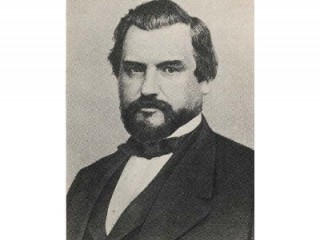
Leland Stanford biography
Date of birth : 1824-03-09
Date of death : 1893-06-21
Birthplace : Watervliet, N.Y.
Nationality : American
Category : Arhitecture and Engineering
Last modified : 2011-10-13
Credited as : railroad builder, industrialist, politician
Leland Stanford, American railroad builder and politician, was one of the founders of the Central Pacific and Southern Pacific railroads and served as California's governor and then U.S. senator.
Leland Stanford, born on March 9, 1824, in Watervliet, N.Y., was one of eight children of a prosperous farmer who also dabbled in various local bridge and road contracts. Leland received a formal education until the age of 12, had 3 years of tutoring at home, and then returned to school. He became an apprentice in an Albany law office and 3 years later gained admission to the bar.
In 1848 Stanford opened a law office at Port Washington, Wis.; meanwhile, his brothers sensed the lure of fortune in California and opened a mercantile business in Sacramento. In 1850 Stanford married Jane Elizabeth Lathrop. Two years later his law office burned down, and he decided to relocate in California. His brothers helped him establish a mining store in Cold Springs, but it did not do well so he opened a business at Michigan Bluff, which was successful. He also engaged in mining on a small scale.
In 1856 Stanford moved to Sacramento, where he started business with a brother and quickly entered politics. He met defeat in a race for Republican state treasurer in 1857, and 2 years later he lost the gubernatorial contest. His golden opportunity came in 1861, when the Civil War split the Democratic party, and he won the governor's office with less than the combined vote of his two Democratic opponents. Though he served only one term, he was able to keep California in the Union. His administration also encouraged the passage of several acts designed to aid the proposed transcontinental railroad, in which he had a large financial interest.
In 1861 Stanford, Collis P. Huntington, Charles Crocker, and Mark Hopkins organized the Central Pacific Railroad, which built east to join the westward-progressing Union Pacific Railroad. The two joined at Promontory Point, Utah, in May 1869. Stanford became president of the Central Pacific, Huntington handled eastern financial and political arrangements, Crocker supervised construction, and Hopkins looked after company finances. Stanford's excellent reputation in California allowed the Central Pacific access to considerable sums of construction money. Also, as a stockholder in the construction companies, he enjoyed great personal profit.
Stanford remained president of the Central Pacific until his death. In 1870 the Southern Pacific was incorporated to build in southern California and eventually to reach New Orleans, La. Fourteen years later a holding company, the Southern Pacific Company, merged the Southern Pacific Railroad, Central Pacific, and others into one combine. Stanford was president of the combine from 1885 to 1890.
In 1890 Stanford and Huntington split over Stanford's renewed political ambitions. After he left the governor's office in 1863, he had remained active in influencing legislation in California. In 1885 he had declared his candidacy for the U.S. Senate and had defeated A. A. Sargent on a strictly party vote. Sargent was a personal friend of Huntington, and in 1890 Huntington managed to have Stanford replaced as Southern Pacific president. Stanford's senatorial career was undistinguished.
Stanford endowed a new institution, the Leland Stanford Junior University, in 1885 in memory of his son, who had died at the age of 15. Stanford died in Palo Alto on June 21, 1893.
















